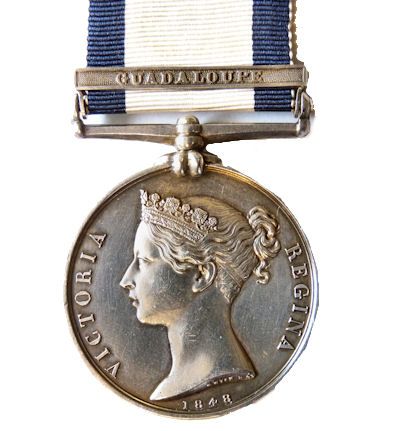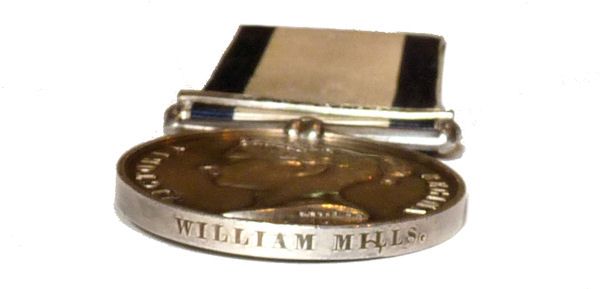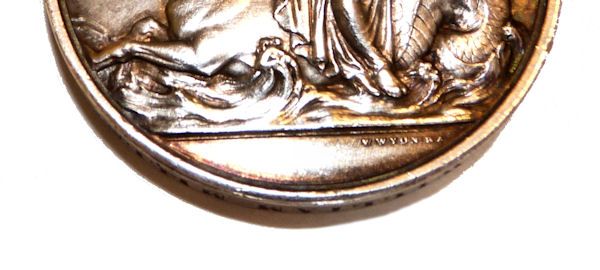RARE BRITISH NAVAL GENERAL SERVICE MEDAL – Guadeloupe Clasp
The Battle of Guadeloupe aboard HMS ROSAMOND!
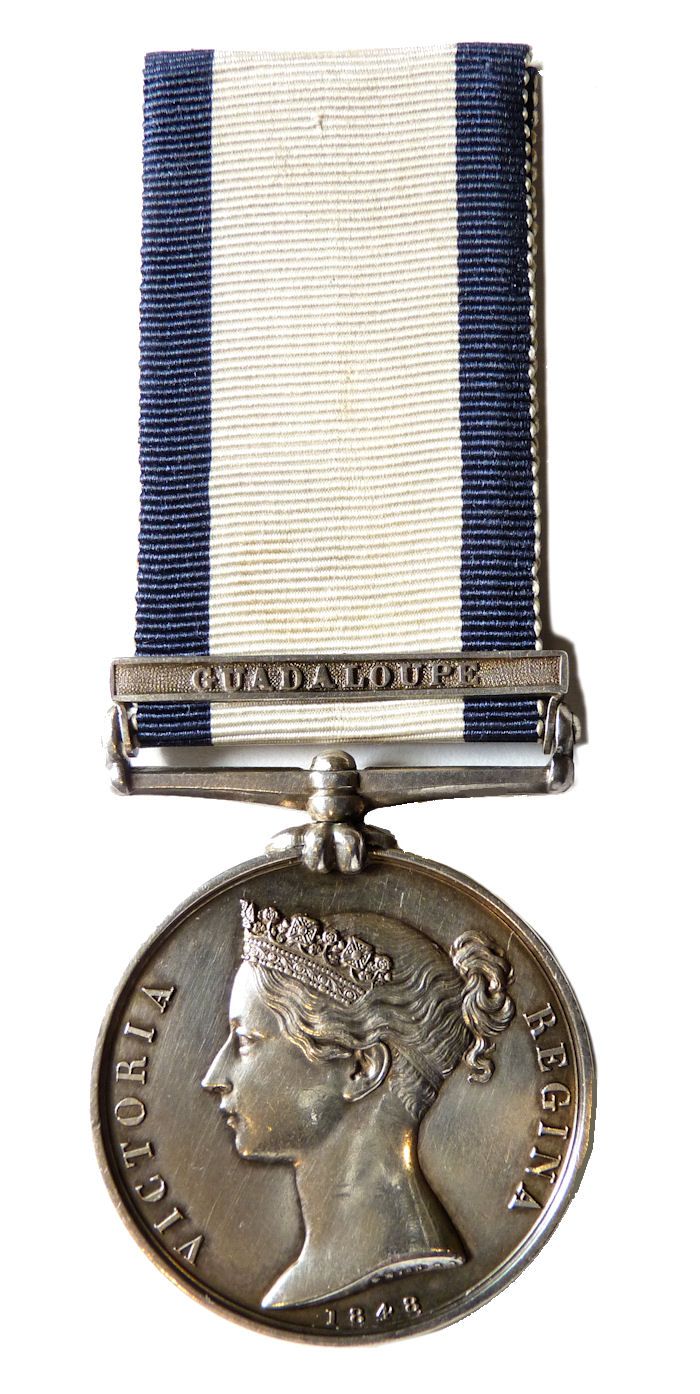
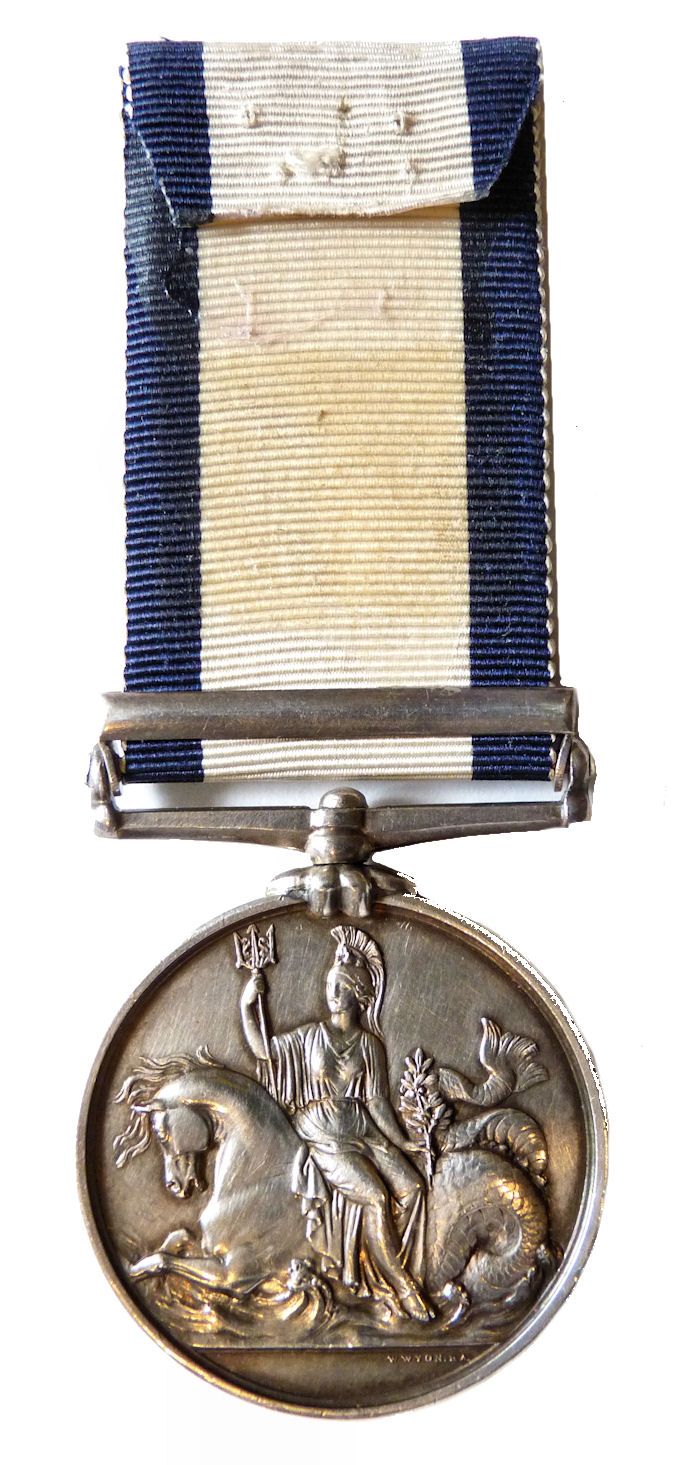
Presented is a very rare example of the British Naval General Service Medal
(NGSM) with Guadeloupe clasp of which only 484 were known to have been issued. This makes
this one of the rarest of medals of this type. Furthermore, the capture of Guadeloupe had a lasting impact on the British
role in the eastern Caribbean for years to come. And, the ship in which the recipient served as a seaman was a small battle
scarred veteran with two significant victories to her credit, before playing a role in the aforesaid capture.AWARD: This medal was
awarded to William Mills , able bodied seaman, and dated 1848. Mills is listed
on page 204 of the book, “The Naval General Service Roll 1793-1840” in HMS ROSAMOND. The
medal is complete with its white ribbon with with blue boarders.MEDAL’S DESCRIPTION:
The Naval General Service Medal was approved in 1847 for issue to officers and men of the Royal Navy retroactively. The obverse
has a portrait of Queen Victoria who was not the reigning monarch during any of this period. The reverse has the symbol of
Britannia holding a trident astride a seahorse with a fish tail.It was awarded for service in various naval
actions from 1793 to 1840, many years after the event. This period included the French Revolutionary Wars, the Napoleonic
Wars and the American English War of 1812. Each of the 231 actions were represented by a clasp which, in the case of Guadeloupe,
is for its capture on 6 February 1810. See more in
MEDAL’S DESCRIPTION continued (below).
OBVERSE dated 1848
REVERSESPECIFICATIONS:
Silver disk 36mm in diameter with clasp and white ribbon with blue edges 32mm in length. The ribbon suspender swivels.MARKINGS: William
MILLS on edge. W.Wyon, RA (Royal Academy) on the reverse in very small bas relief under the seahorse’s tail.CONDITION:
Super fine with a nice patina of age. Both sides of the ribbon are glued together, and there is evidence on the back of the
ribion showing it was glued to something for display.HMS ROSAMOND: The ROSAMOND
was launched in 1807 as a 5th rate sloop. She displaced 1059 tonnes, carrying 18 guns and was crewed by 160
officers and men. On 26 June 1807 she captured the Dutch privateer Amotellan of 12 guns and 60 men. On 17 December 1809
under Captain Benjamin Walker, off the island of Santa-Cruz, she captured the French 16 gun Corvette, Papillon.
The Papillon mounted, like
the rest of her class, 14 carronades, 24-pounders, and two sixes, with 30 troops, a crew of 110 men and boys; it had
been 33 days from Bordeaux, and was carrying a cargo of flour to Guadaloupe. Being a fine brig of 343 tons, and only two years
old, the Papillon was added to the British navy under the same name. In
1810, Rosamond served in the capture of Guadeloupe. After the battle, she was transferred to various assignments and
stations in Canada, England and the Mediterranean until she was scrapped in 1815.PROVENANCE: From a private
collection in the United States which aquired it from Spink, London in December, 1981, as from the Colonel
Murray Collection, P.T.O.THE GUADELOUPE CAMPAIGN:
The Invasion of Guadeloupe was a British amphibious operation fought between 28 January and 6 February 1810 over control of
the Caribbean island of Guadeloupe during the Napoleonic Wars. The island was the final remaining French colony in the Americas,
following the systematic invasion and capture of the others during 1809 by British forces. During the Napoleonic Wars, the
French colonies had provided protected harbors for French privateers and warships, which could prey on the numerous British
trade routes in the Caribbean, and then return to the colonies before British warships could react. In response, the British
instituted a blockade of the islands, stationing ships off every port and seizing any vessel that tried to enter or leave.
With trade and communication made dangerous by the British blockade squadrons, the economies and morale of the French colonies
began to collapse, and in the summer of 1808 desperate messages were sent to France requesting aid.Despite repeated efforts, the French Navy failed
to reinforce and resupply the garrison, as their ships were intercepted and defeated either in European waters or in the Caribbean
itself. The British had intercepted a number of these messages, and launched a series of successful invasions during 1809,
until Guadeloupe was the only French colony remaining. A British expeditionary force landed on 28 January 1810, and quickly
over came limited resistance, and in a battle on February 3rd, defeated the French.The island’s commander, Jean Augustin
Ernouf, began surrender negotiations the following day.
|
MEDAL’S DESCRIPTION
Continued:The medal covered a variety of types of actions, from ship to ship skirmishes all the way to major fleet
battles. The medal was never issued without a clasp.It was only awarded to surviving veterans who were
alive in 1847 and had applied. Because of poor communication and lack of reading ability, most of those eligible
failed to apply. Consequently, only 20,933 medals were issued, most with a single clasp. This is far less then the
number of men who served in the action and accounts for the limited supply.The final date for submitting applications was May
1, 1851. None were awarded posthumously unless applied for before death. This medal and the Army equivalent were the first
British campaign medals.SYNOPSIS: No fewer than 230
different clasps for major battles, minor engagements, cutting-out operations and boat service from 1793 to 1840 were authorized
for this medal. This is one of an estimated 484 Naval General Service Medals with the Guadeloupe clasp that the British Royal
Navy awarded. Hence, it is one of the rarest. The rim of the silver medal is marked “WILLIAM MILLS”. The white ribbon has
dark blue edges. As stated it has the Guadeloupe clasp. According to the Rolls, William Mills was aboard HMS Rosamund
as an Able Seaman.
BACKGROUND: The French West Indian colonies during the
Napoleonic Wars were almost completely cut off from France due to the British naval strategy of blockades: squadrons
of British Royal Navy warships patrolled the coasts of both France, and the West Indian islands under French control. This
hindered communications, severely restricted trade and prevented the reinforcement of the French garrisons during the conflict.
As a result, the colonies began to suffer food shortages, their economies stagnated and public and military morale began to
severely erode. In desperation, the commanders of the main colonies, the Leeward Islands of Martinique and Guadeloupe, sent
a series of messages to France during the summer of 1808, entreating the French government to send food and military supplies.
The French responded with a series of frigates and smaller vessels, sailing to the Caribbean. Some of these ships reached
their destinations, but the majority were captured by the Royal Navy blockades. Those few ships that did safely make port
were trapped there, unable to make the return journey without risking defeat by the British ships waiting offshore.The British decided to invade and capture the French West
Indies before substantial reinforcements could arrive. During the winter of 1808, ships and troops from across the Caribbean
were gathered off Barbados under the command of Vice-Admiral Sir Alexander Cochrane and Lieutenant General George Beckwith,
with the intention of invading Martinique early in 1809. A smaller force was sent to Cayenne, which was invaded and captured
in early January 1809. In late January, the invasion of Martinique began, and the island fell in 25 days. In
April 1809, a strong French reinforcement squadron arrived at the Îles des Saintes, south of Guadeloupe. There they were blockaded
until 14 April, when a British force under Major-General Frederick Maitland invaded and captured the islands. In the attempt
to escape, the ship of the line Hautpoult was captured and two French frigates were trapped in Basse-Terre on Guadeloupe.
In June, the frigates attempted to return to France. Only one of the frigates escaped the blockade squadron, although the
escapee was also captured a month later in the North Atlantic.Subsequent French attempts to supply their one remaining colony
on Guadeloupe were minor, most of the brigs sent were seized without reaching the island. The only significant attempt, launched
in November 1809, achieved initial success in the destruction of the British frigate HMS Junon on 13 December, but ultimately
failed when the two armed store ships, Loire and Seine were destroyed on 18 December in a battle with a British squadron off
the southern coast of Guadeloupe. During the autumn and winter, British forces were collected from across the Caribbean at
Fort Royal, Martinique, under Cochrane and Beckwith for the invasion of Guadeloupe. Credit Wikipedia for much of this with editing.SHIPPING
& PACKING: The cost of shipping, packing, handling, and insurance to your destination, is
an additional charge. You may email us to get these costs. We price our shipping honestly, but we expect to
be reimbursed for the nominal cost of packaging materials and handling.OUR UNCONDITIONAL NO NONSENSE GUARANTEE: If not completely
satisfied with your purchase it may be returned within five days of receipt in its original packaging if without damage.
Return items must be insured for their full value. Only a prior email authorization from us for the return is required. Shipping
charges are included in this offer if an error is due to our fault.International buyers welcome, but should inquire
first. We have satisfied customers in Argentina, Australia, Austria, Belgium, Bermuda, British Virgin
Islands, Canada, Chile, China, Czech Republic, Democratic Republic of Congo, Denmark, Estonia, England, France, Germany,
Greece, Holland, Hong Kong, Hungary, Iceland, Ireland, Israel, Italy, Japan, Kuwait, Latvia, Malaysia, Martinique, Mexico,
New Zealand, Norway, Nova Scotia, Panama, Poland, Portugal, Puerto Rico, Romania, Saudi Arabia, Scotland, Singapore,
Spain, Sweden, Switzerland, Thailand, Turkey, United Arab Emirates, USVI and the Eastern Caribbean.ACCEPTED FORMS OF PAYMENT are Bank wire transfer, cashier’s check, or personal check in which
case the item will be held until cleared. Our prices are quoted net to seller, but credit cards may be accepted
through PayPal for verified members by special arrangement.
Copyright 2012 by Land
And Sea Collection™, All Rights Reserved
![]()
The Battle of Guadeloupe aboard HMS ROSAMOND!   |
Presented is a very rare example of the British Naval General Service
Medal (NGSM) with Guadeloupe clasp of which only 484 were known to have been
issued. This makes this one of the rarest of medals of this type. Furthermore, the capture of Guadeloupe had a lasting impact
on the British role in the eastern Caribbean for years to come. And, the ship in which the recipient served as a seaman was
a small battle scarred veteran with two significant victories to her credit, before playing a role in the aforesaid capture.AWARD: This medal was
awarded to William Mills, able bodied seaman, and dated 1848. Mills is listed
on page 204 of the book, “The Naval General Service Roll 1793-1840” in HMS ROSAMOND. The
medal is complete with its white ribbon with with blue boarders.MEDAL’S DESCRIPTION:
The Naval General Service Medal was approved in 1847 for issue to officers and men of the Royal Navy retroactively. The obverse
has a portrait of Queen Victoria who was not the reigning monarch during any of this period. The reverse has the symbol of
Britannia holding a trident astride a seahorse with a fish tail.It was awarded for service in various naval
actions from 1793 to 1840, many years after the event. This period included the French Revolutionary Wars, the Napoleonic
Wars and the American English War of 1812. Each of the 231 actions were represented by a clasp which, in the case of Guadeloupe,
is for its capture on 6 February 1810. See more in MEDAL’S
DESCRIPTION continued (below).
OBVERSE dated 1848
REVERSESPECIFICATIONS:
Silver disk 36mm in diameter with clasp and white ribbon with blue edges 32mm in length. The ribbon suspender swivels.MARKINGS:
William MILLS on edge. W.Wyon, RA (Royal Academy) on the reverse in very small bas relief under the seahorse’s tail.CONDITION:
Super fine with a nice patina of age. Both sides of the ribbon are glued together, and there is evidence on the back of the
ribion showing it was glued to something for display.HMS ROSAMOND: The ROSAMOND was launched
in 1807 as a 5th rate sloop. She displaced 1059 tonnes, carrying 18 guns and was crewed by 160 officers and
men. On 26 June 1807 she captured the Dutch privateer Amotellan of 12 guns and 60 men. On 17 December 1809 under Captain
Benjamin Walker, off the island of Santa-Cruz, she captured the French 16 gun Corvette, Papillon. The Papillon mounted, like the rest of her class, 14 carronades, 24-pounders, and two sixes, with 30 troops, a crew of 110
men and boys; it had been 33 days from Bordeaux, and was carrying a cargo of flour to Guadaloupe. Being a fine brig of
343 tons, and only two years old, the Papillon was added to the British navy under the same name. In 1810, Rosamond served in the capture of Guadeloupe. After the battle, she was transferred to
various assignments and stations in Canada, England and the Mediterranean until she was scrapped in 1815.THE GUADELOUPE CAMPAIGN:
The Invasion of Guadeloupe was a British amphibious operation fought between 28 January and 6 February 1810 over control of
the Caribbean island of Guadeloupe during the Napoleonic Wars. The island was the final remaining French colony in the Americas,
following the systematic invasion and capture of the others during 1809 by British forces. During the Napoleonic Wars, the
French colonies had provided protected harbors for French privateers and warships, which could prey on the numerous British
trade routes in the Caribbean, and then return to the colonies before British warships could react. In response, the British
instituted a blockade of the islands, stationing ships off every port and seizing any vessel that tried to enter or leave.
With trade and communication made dangerous by the British blockade squadrons, the economies and morale of the French colonies
began to collapse, and in the summer of 1808 desperate messages were sent to France requesting aid.Despite repeated efforts, the French Navy failed
to reinforce and resupply the garrison, as their ships were intercepted and defeated either in European waters or in the Caribbean
itself. The British had intercepted a number of these messages, and launched a series of successful invasions during 1809,
until Guadeloupe was the only French colony remaining. A British expeditionary force landed on 28 January 1810, and quickly
over came limited resistance, and in a battle on February 3rd, defeated the French.The island’s commander, Jean Augustin
Ernouf, began surrender negotiations the following day.
|
MEDAL’S DESCRIPTION
Continued:The medal covered a variety of types of actions, from ship to ship skirmishes all the way to major fleet
battles. The medal was never issued without a clasp.It was only awarded to surviving veterans who were
alive in 1847 and had applied. Because of poor communication and lack of reading ability, most of those eligible
failed to apply. Consequently, only 20,933 medals were issued, most with a single clasp. This is far less then the
number of men who served in the action and accounts for the limited supply.The final date for submitting applications was
May 1, 1851. None were awarded posthumously unless applied for before death. This medal and the Army equivalent were the first
British campaign medals.SYNOPSIS: No fewer than 230 different clasps for major battles,
minor engagements, cutting-out operations and boat service from 1793 to 1840 were authorized for this medal. This is one of
an estimated 484 Naval General Service Medals with the Guadeloupe clasp that the British Royal Navy awarded. Hence, it is
one of the rarest. The rim of the silver medal is marked “WILLIAM MILLS”. The white ribbon has dark blue edges. As stated
it has the Guadeloupe clasp. According to the Rolls, William Mills was aboard HMS Rosamund as an Able Seaman.
BACKGROUND: The French West Indian colonies during the
Napoleonic Wars were almost completely cut off from France due to the British naval strategy of blockades: squadrons
of British Royal Navy warships patrolled the coasts of both France, and the West Indian islands under French control. This
hindered communications, severely restricted trade and prevented the reinforcement of the French garrisons during the conflict.
As a result, the colonies began to suffer food shortages, their economies stagnated and public and military morale began to
severely erode. In desperation, the commanders of the main colonies, the Leeward Islands of Martinique and Guadeloupe, sent
a series of messages to France during the summer of 1808, entreating the French government to send food and military supplies.
The French responded with a series of frigates and smaller vessels, sailing to the Caribbean. Some of these ships reached
their destinations, but the majority were captured by the Royal Navy blockades. Those few ships that did safely make port
were trapped there, unable to make the return journey without risking defeat by the British ships waiting offshore.The British decided to invade and capture the French West
Indies before substantial reinforcements could arrive. During the winter of 1808, ships and troops from across the Caribbean
were gathered off Barbados under the command of Vice-Admiral Sir Alexander Cochrane and Lieutenant General George Beckwith,
with the intention of invading Martinique early in 1809. A smaller force was sent to Cayenne, which was invaded and captured
in early January 1809. In late January, the invasion of Martinique began, and the island fell in 25 days. In
April 1809, a strong French reinforcement squadron arrived at the Îles des Saintes, south of Guadeloupe. There they were blockaded
until 14 April, when a British force under Major-General Frederick Maitland invaded and captured the islands. In the attempt
to escape, the ship of the line Hautpoult was captured and two French frigates were trapped in Basse-Terre on Guadeloupe.
In June, the frigates attempted to return to France. Only one of the frigates escaped the blockade squadron, although the
escapee was also captured a month later in the North Atlantic.Subsequent French attempts to supply their one remaining colony
on Guadeloupe were minor, most of the brigs sent were seized without reaching the island. The only significant attempt, launched
in November 1809, achieved initial success in the destruction of the British frigate HMS Junon on 13 December, but ultimately
failed when the two armed store ships, Loire and Seine were destroyed on 18 December in a battle with a British squadron off
the southern coast of Guadeloupe. During the autumn and winter, British forces were collected from across the Caribbean at
Fort Royal, Martinique, under Cochrane and Beckwith for the invasion of Guadeloupe. Credit Wikipedia for much of this with editing.
